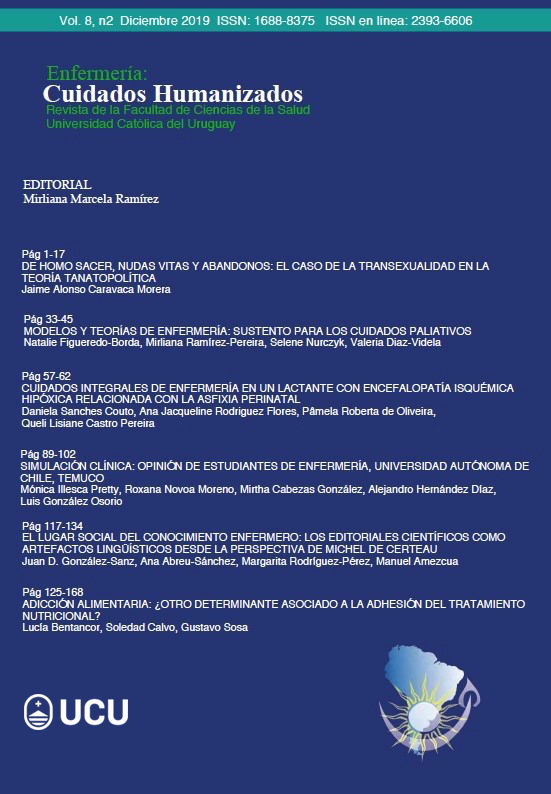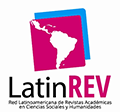COMPREHENSIVE NURSING CARE IN AN INFANT WITH HYPOXIC ISCHEMICAL ENCEPHALOPATHY RELATED TO PERINATAL ASPHYXIA
DOI:
https://doi.org/10.22235/ech.v8i2.1847Abstract
Hypoxic ischemic encephalopathy, secondary to asphyxia during childbirth, remains an important cause of postnatal death and permanent neurological deficit in the world. Nursing interventions continue as the pillar of the treatment, allowing some comfort to the patient. The study aimed to implement the nursing process in the care of a pediatric patient with brain damage as a consequence of perinatal asphyxia. We conducted a clinical case study in a Pediatric Intensive Unit in Durango, Mexico, in November and December 2017. The data was obtained after the evaluation and presented in the nursing process in its phases of history, evolution, diagnosis, planning of the interventions and results obtained. We emphasize the importance of the process as a focus of the nurse's work, capable of enabling the development of evidence-based care and also to enhance its credibility.
Downloads
References
2. Lemus-Varela M, Sola A, Golombek S, Baquero H, Dávila-Aliaga C, Fariña D, et al. Recomendaciones terapeuticas del VII Consenso Clinico de SIBEN para la encefalopatia hipoxico-isquemica neonatal. Neoreviews [Internet]. 2016; 17 (9): 554–67. Disponible en: http://neoreviews.aappublications.org/cgi/doi/10.1542/neo.17-9-e554
3. Balushi A, López M, Wintermark P. Impacto de la ventilación en el desarrollo de daño cerebral en recién nacidos con asfixia, tratados con hipotermia. Anest en México. 2017;2 9(1): 30–40.
4. Grupo de Trabajo Hipotermia Terapéutica C de EF-N (CEFEN). Recomendación para el tratamiento con hipotermia en recién nacidos con encefalopatía hipóxico- isquémica. Arch Argent Pediatr [Internet]. 2017;115 (3:s):38–52. Disponible en: http://www.sap.org.ar/docs/publicaciones/archivosarg/2017/v115n3a26s.pdf
5. Rivera M, Lara N, Baró T. Asfixia al nacer: factores de riesgo materno y su repercusión en la mortalidad neonatal. Rev Ide Inf Científica. 2017; 96 (6): 1143–52.
6. Barbosa M de LG, Castro CMMB de, Telles MVL, Belarmino ALB, Parente LLT, Mendonça A, et al. Prevalência de Hipóxia Perinatal em Gemelares da Maternidade Pública em Juazeiro do Norte-CE. Id Line Rev Psic. 2016;10 (31): 202–23.
7. Riesgo-prendes L, Salamanca Matta A, Monterrey Gutiérrez P, Bermúdez Hernández P, Vélez J. Hipoxia perinatal en el Hospital Mederi de Bogotá: comportamiento en los años 2007 a 2011. Rev Salud Pública. 2017; 19 (3): 332–9.
8. Segur P, Morero J, Oliveira C. Assistência de Enfermagem ao recém-nascido com Sindrome do Desconforto Respiratório. Rev UNINGÁ. 2019;56 (S2): 141–59.
9. Hernández EES. Síndrome Rusell Silver. Presentación de caso. Rev Méd Electrón [Internet]. 2018 ;40(3): 784–9.
10. Silvera F, Gesuele JP, Oca RM, Vidal G, Martínez V, Lucas L, et al. Neuroprotección en pacientes con asfixia perinatal. Arch Pediatr Urug. 2016 ;87(3): 221–33.
Downloads
Published
How to Cite
Issue
Section
License
Copyright (c) 2019 Enfermería: Cuidados Humanizados

This work is licensed under a Creative Commons Attribution 4.0 International License.

















